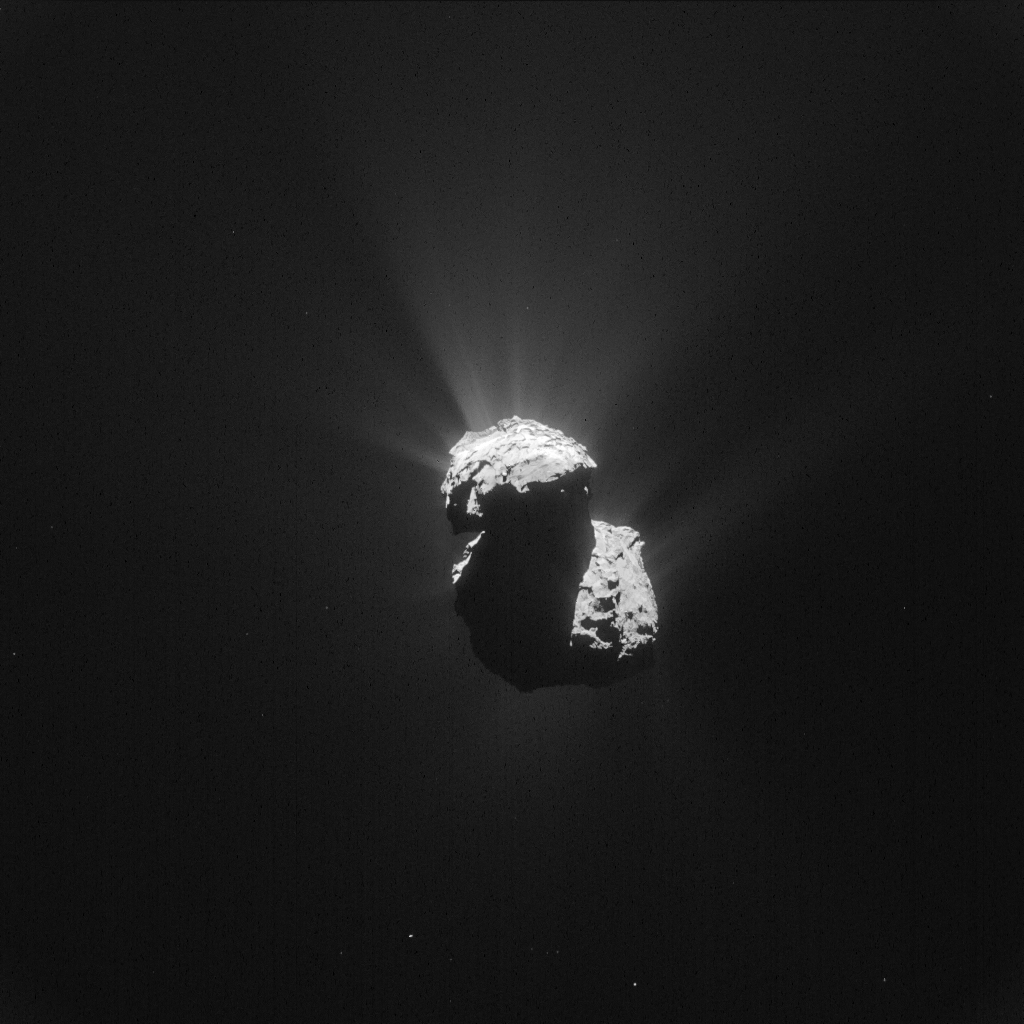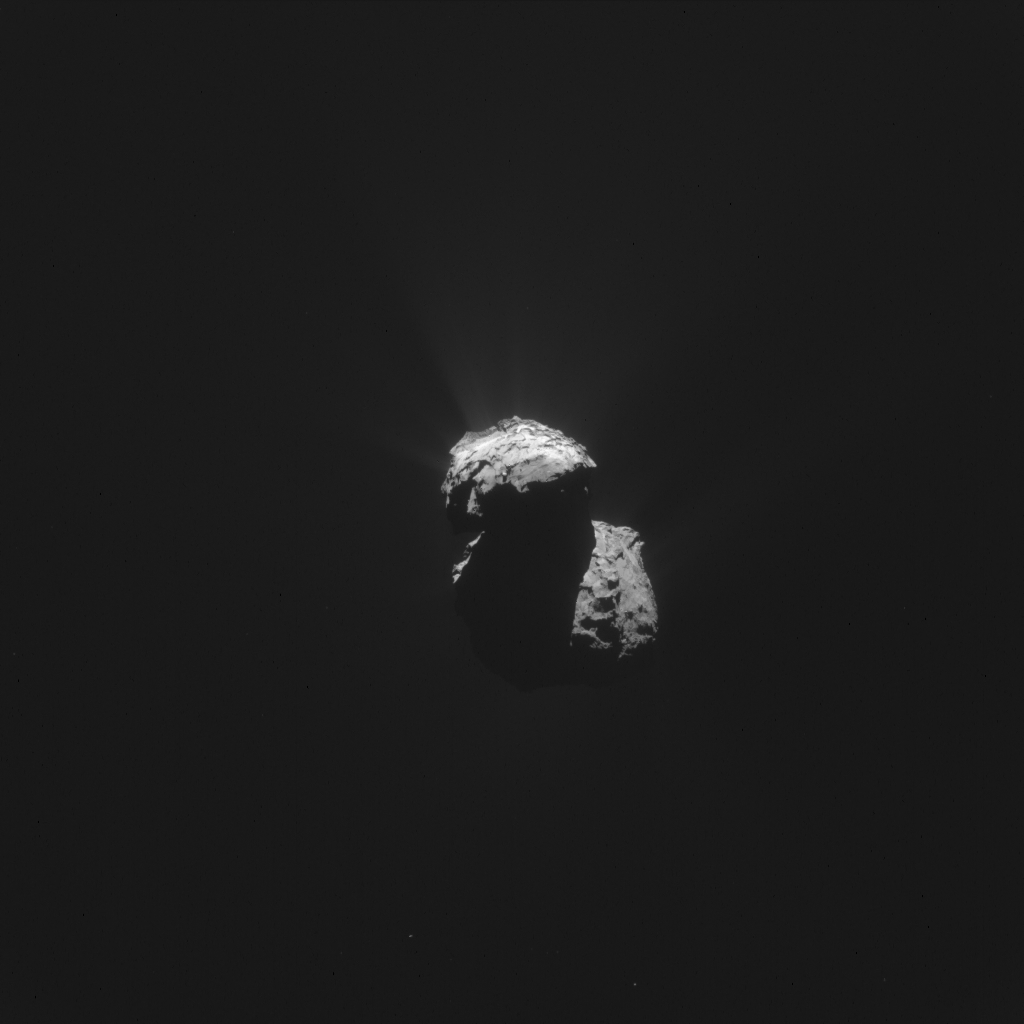Today’s CometWatch entry is a single frame NAVCAM image taken on 14 June, when Rosetta was 203 km from the centre of Comet 67P/Churyumov-Gerasimenko. The resolution is 17.3 m/pixel and the image measures 17.7 km across.

NAVCAM image of Comet 67P/C-G taken on 14 June 2015 from a distance of 203 km to the comet centre. Credits: ESA/Rosetta/NAVCAM – CC BY-SA IGO 3.0
The image was processed in LightRoom to enhance the activity of 67P/C-G, resulting in a powerful juxtaposition of contrasts. Pointing upwards, the small comet lobe shows the narrow and bouldered regions of Serqet and Nut, along with some parts of Ma’at and Maftet. A hint of the large Hatmehit depression can also be seen towards the top left, its outer rim nicely framed by outflowing material in the background.
Anuket and Hapi, on the comet’s neck, are cast in the shadow of the small lobe. Parts of the large lobe are also hidden in the shadows, while the illuminated portion reveals some of the circular features of the Seth region and, to their right, the smoother terrains of Anubis, punctuated with a few boulders.
In the lower part of the image, the dark portions of the large lobe stand out against the brighter background of the coma. Interestingly, this can be seen also in the original (unprocessed) 1024 x 1024 image, which is provided below:










Discussion: 18 comments
Interesting. It does seem that the images since early in June seem to show decreased activity of the North Polar Jets. I wonder if this is true, or if it’s a coincidence of the selection of the images presented ?
Activity on the “Outer” end of the Small Lobe seems to have increased.
–Bill
In follow up to my comment on the 17/06/15 post, this picture also clearly shows perfectly parallel jets. In fact, in looking back through many pictures, it seems the actual norm for many of the columns, many of which are huge at their base (half a kilometer or more), is to be composed of many individual, very wide (many meters across at least) jets that rise far above the surface of the comet all in the exact same direction. How is this possible? For the jets to remain parallel over that much distance requires very very precisely (pretty much perfect) alignment. Just imagine two people firing rifles into the air so that the bullets travel exactly parallel. Almost impossible to achieve, and any slight shift would throw it off, yet here we have the equivalent of that happening everywhere on P67. And many of those jets are pretty far apart, yet they’re still parallel. So again, please explain to me how this is possible.
The very wide jet emerging from Hatmehit may be coming from one of several very thin fissures that are arranged in v-shapes across Hatmehit. Together they form a chevron pattern. They are extremely narrow, almost unresolvable in the NAVCAM pics but they are there and traceable up and over the rim to the south pole strata.
So the narrow width and length of these fissures may explain the narrow width and sheet-like appearance of this wide jet. However, one would not expect an exact sheet-like surface because anomalies along the fissure could be expected to cause some divergence from the average plane through which the jet is travelling. I suspect that might be a line-of-sight issue though.
i’m wondering why the outflowing material (dust/gas) always follows very straight trajectories. shouldn’t these look twisted due to the comet’s rotation?
You are right that theoretically it should follow a slightly twisted path. The theory I have is that the rotational period of the comet is too large compared to the time that it takes the dust streams to disperse for you to notice a twisted pattern. I imagine there will be some slight curvature in the streams as the sources of the streams move but you would’t be able to make it out.If the comet tail is very long and there are several distinct streams making it up it may be possible to notice this effect you mentioned and I would be very interested to see if it works!
I find the unprocessed image even more exciting!
I agree, the unprocessed image is more amazing than the processed one
Amazing picture, and just truly amazing that you landed on that waiting for that countdown! Excellent work people !
The out gassing looks like it is being expelled through long”pipes” the jets seem square to the surfaces they are emerging from and parallel to each other in given areas. Is all the action happening well beneath the crust as in the NASA article re deep fried ice cream? Thanks again for the blog!
Yes. By various measurements of the volatile depleted crust, these pipes are, as you say perpendicular to the surface, and about 50 metres long. High molecular weight PAH’s that are solid and not porous at the crust, would be needed to conduct the heat from the surface down 50 metres to the volatiles sublimating/evaporating. Evaporating volatiles would then force their way through the crust taking the path of least resistance, which is perpendicular to the surface.
The circumstantial evidence is mounting for this scenario. Many cliff features around 50 metres where crust has fractured off, lack of surface erosion, parallel jets perpendicular to surface, aromatic compounds discovered, hard, black, brittle surface, etc.
Fascinating! Yes you can clearly see the “cross sections ” of these pipes in some closeups.
Marco, re 50 m tubes
I don’t totally follow your reasoning Marco, there are some features on the surface that could be the top of missing tubes, albeit there appears to be no hole in the middle stretching 50 meters deep. 50 m sounds very deep if we are looking for a conduction of heat.
Also most of the columns we see are very large, hundreds of meters across, some of these look to be coming from large craters, so it looks like a surface erosion with no hole to the interior to the comet. The amount of dust picked up by these columns seems unlikely from a pipe, I can imagine how dust may join the gar with erosion from the nozzle and cavity, but its not so obvious how the gas expand so much when it comes through the hole to pick up surface dust.
Also there are many columns far more that the likely tubes we can see at the moment.
Of course there are probably more than 1 way that these columns of dust and gas form
Hi Dave,
At first sight it might seem obvious that the large craters are eroding at their base. However, it has been months and the craters have seen outgassing, but are no deeper than when they were first imaged. Similarly, all areas with significant outgassing have not shown any surface changes with images taken months apart. The pipes would be very small and numerous, and dust would be transported through the pipes with the vapour. The craters you mention would have numerous pipes each.
The cliffs around Hatmehit have vertical lines which are evidence of the vertical pipes that were there before the 50m crust broke off forming the Hatmehit crater.
A high proportion of PAHs and low porosity of the 50m crust would be required for the observed conduction of heat to lower depths of that scale.
Hi Marco,
While its a possibility there are lots of small pipes under the surface all parallel and in the same direction it seem a little unlikely for me.
I am not sure the lines we see on the cliffs are evidence of pipes either, for me they look more like erosion marks from dust in the large columns we see once they are free from the ground. Or they may be evidence of stratified rock/ice or what ever the surfaces are made of.
The published material on the blog ruled out a porous surface in favour of an underground cavity with a pipe to the surface but not at a 50m depth.
The carbonaceous chondrite remnants of meteorites found on earth that have been postulated as being similar to the surface composition of this comet show some porosity, but not on the scale you are suggesting.
However now that The OSIRIS team are releasing information, there just may be some better evidence of what is actually going on.
I guess we have to continue to wait. I am not holding my breath though.
regards
Hi Marco,
you don’t get the needed heat conduction through a layer of 50 m, not even within a year.
Naturally occuring PAHs on the comet don’t do it; that’s a dead-end.
We are talking mostly about the top few centimeters.
Some super-volatiles in “deeper” layers (still less than 50 m) might be affected from the overall closer orbit to the Sun since 1959.
But those effects can show up at any time, independent of the short-term distance to the Sun.
Hi Gerald,
I would have taken your word for it, but a chemist I have been talking to is quite adamant that 50 metres can work if a fractionation process has occured that concentrates PAHs in that 50 metres. I have heard that they can be as thermally conductive as metal. Graphene is, of course the ultimate PAH for thermal conductivity, but less likely to be naturally occurring from a fractionation process than lesser PAHs.
Plus, you don’t get the latent cooling due to sublimation that counters the thermal exchange if the volatiles are all deeper. As soon as heat conducts down to a volatile, the sublimating volatile stops the heat transfer.
Good job. Pictures are breath taking. Cant wait to hear from lil philae about the mysteries of the universe.
ESA you guys are going a great job well done ,